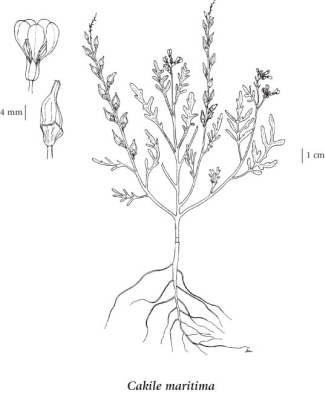European searocket
Brassicaceae (Mustard family)
Introduction to Vascular Plants
SUBTAXA PRESENT IN BC
Introduction
European sea rocket is an introduced European species of coastal beach systems that is now found in North America in several US states (AL, CA, MD, NC, NJ, NY, OR, PA, TX, VA, WA) and one Canadian province (BC) (USDA 2010). In BC, it was known only from the west coast of Vancouver Island and the Queen Charlotte Islands until 2007, when it appeared in the Greater Vancouver area. Lomer (pers. com. 2009) reports that it appeared in that part of BC following a major storm in February 2006 that flooded homes in the Tsawwassen area. "The storm surge altered the beach, killing several inland shrubs and plants with salt water and covering acres with fresh deposits of sand. The next spring thousands of Cakile maritima showed up all over the beach at Tsawwassen...[it] is abundant at Boundary Bay now". This is an often sprawling, sometimes erect, annual taprooted beach species with distinctly pinnately lobed, stalked, lower leaves that are 3-6 cm long. Flowers are a pale lavender.
|
Species Information
General:
Annual herb from a taproot; stems branched, 15-45 cm long, prostrate or ascending.
Leaves:
Basal leaves egg-shaped or oblanceolate to deeply pinnately lobed, fleshy, the lower leaves usually distinctly pinnately lobed, stalked, 3-6 cm long; upper stem leaves less lobed or entire, unstalked.
Flowers:
Inflorescence a raceme; flower stalks 3-7 mm long, stout, ascending; petals purple, lilac or white, 6-10 mm long; sepals 3-5 mm long.
Fruits:
Siliques, 1.5-3 cm long, usually expanded at the joints into projecting wings, the upper segment twice as long as lower, conic to cylindric, tips acute to blunt.
Illustration

If more than one illustration is available for a species (e.g., separate illustrations were provided for two subspecies) then links to the separate images will be provided below. Note that individual subspecies or varietal illustrations are not always available.
Illustration Source: The Illustrated Flora of British Columbia
Ecology
The table below shows the species-specific information calculated from
original data (BEC database) provided by the BC Ministry of Forests and Range.
(Updated August, 2013)
| Site Information |
Value / Class |
||
|
Avg |
Min |
Max |
|
| Elevation
(metres) |
10 | 9 | 11 |
| Slope
Gradient (%) |
2 | 2 | 2 |
|
Aspect (degrees) |
0 | ||
| Soil
Moisture Regime (SMR) [0 - very xeric; 4 - mesic; 8 - hydric] |
2 | 2 | 2 |
| Modal
Nutrient Regime
Class |
A | ||
| #
of field plots species was recorded in: |
2 | ||
| Modal
BEC Zone Class |
CWH | ||
|
All BEC Zones (# of stations/zone) species was recorded in |
CWH(2) | ||
|
Source:
Klinkenberg 2013
|
|||
Habitat and Range
Mesic to moist disturbed areas in the lowland zone; rare in SW BC, known only from the W coast of Vancouver Island and the Queen Charlotte Islands; introduced from Europe.Status Information
Synonyms
Synonyms and Alternate Names:
Cakile cakile (L.) Karst.
Taxonomic Keys
1. Silicles slightly to much constricted at the joints, leaves mostly spoon-shaped or egg-shaped, wavy-margined and toothed, sometimes pinnately lobed or nearly entire......................................C. edentula
1. Silicles usually expanded at the joints into projecting wings; at least the lower leaves usually distinctly pinnately cleft..........................C. maritima Source: Illustrated Flora of British Columbia. |
Taxonomic Notes
Until 2006, this species was known only from Vancouver Island and the Queen Charlotte Islands. However, it is now reported from the BC mainland at Boundary Bay (Lomer 2009) and Iona Beach (Benson 2009, Taylor 2008). According to Lomer, following a wind storm and storm surge in February 2006, the beach in Tsawwassen was inundated with salt water and acres of fresh sand were deposited. "The next spring, thousands of Cakile maritima showed up all over the beach at Tsawwassen". The same storm likely brought the species to the Iona sand spit.
Note Author R. Klinkenberg August 2009 References Benson, Don. 2009. Personal communication. E-mail. Lomer, Frank. 2009. Personal communication. E-mail. Taylor, Terry. 2008. Correspondence to Frank Lomer 2008 E-mail. Taxonomic Key to Cakile 1. Silicles slightly to much constricted at the joints, leaves mostly spoon-shaped or egg-shaped, wavy-margined and toothed, sometimes pinnately lobed or nearly entire......................................C. edentula 1. Silicles usually expanded at the joints into projecting wings; at least the lower leaves usually distinctly pinnately cleft..........................C. maritima Source Douglas, George W., Gerald B. Straley, Del Meidinger and Jim Pojar. 1998. Illustrated Flora of British Columbia, Volume 2: Dicotyledons (Balsaminaceae through Cuscutaceae). British Columbia Ministry of Environment, Lands and Parks and BC Ministry of Forests, Victoria. |